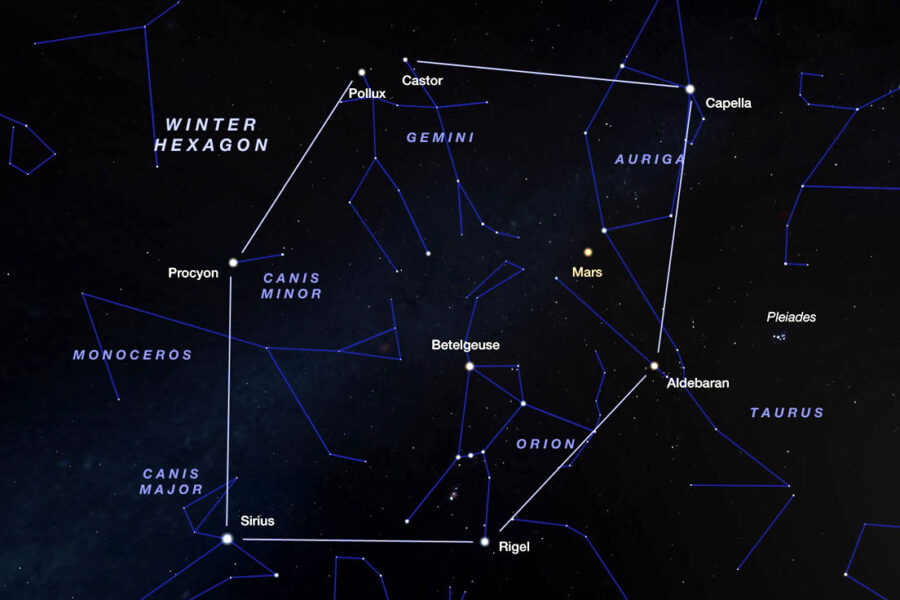As the Northern Hemisphere edges toward the March equinox and beyond, stargazers have an abundance of brilliant stars overhead as darkness falls. Anchoring the celestial parade is Orion, the Hunter. Download or listen to this month’s Sky Tour to learn about — and how to spot — the Winter Hexagon of big, beautiful winter stars.

Listen Here:
Podcast: Play in new window | Download
Subscribe: Apple Podcasts | Google Podcasts | Spotify | Email | RSS | More
Besides the switch to daylight time in the Northern Hemisphere (which few stargazers are crazy about), March is also when Earth reaches one of the two equinox points in its year-long orbit. This month it falls on the 20th at 5:24 p.m. Eastern Daylight Time. On this date, days and nights everywhere are both 12 hours long. And, if you’re directionally challenged, on the equinox the Sun rises due east and sets due west no matter where you are.
The real showpiece these March evenings is Venus. This month starts off with a celestial bang, because on March 1st Venus and Jupiter will pair together just ½° apart — so close together that you’ll be able to cover them both with the tip of your littlest finger. In the days thereafter, Jupiter will slowly slide lower down, so enjoy it while you can. Meanwhile, Venus will gradually rise higher in the west at dusk each evening. How soon after sunset can you spot Venus? Thirty minutes afterward should be a slam-dunk, but 15 or 20 minutes will be a good test of your vision.
Did you know that Venus has an interesting repeating sky appearance that serves as a key part of the ancient Maya calendar? Listen to this month’s Sky Tour to find out all about it.
The full Worm Moon falls March 7th, so the last half of March will feature Moon-free evening skies. Once it gets dark, all the brilliant stars of winter are arrayed before us in all their glory. Probably easiest to spot is Orion, the Hunter. Look for a distinctive row of three stars in a roughly horizontal line that mark the Hunter’s Belt. To the belt’s lower right is the star Rigel, which marks his foot. To the belt’s upper left, at Orion’s shoulder, is the bright star Betelgeuse. It’s often stated that this is an Arabic phrase meaning “the armpit of Orion.” But a more careful translation of the original Arabic probably refers to his hand.

Source: Stellarium
Betelgeuse is at the center of a huge hexagon in the sky. At the very top is Capella. Going around clockwise, you’ come to Aldebaran, then Rigel, then Sirius at the bottom. To its upper left are Procyon, the twins of Gemini (Castor and Pollux), and finally back to Capella. Skywatchers know this pattern as the Winter Hexagon, and all of these stars are bright enough to show up even if you have a lot of light pollution where you live.
Sirius is the real “star” of the winter season. But you can see it throughout much of the year if you know when to look. Sometime in August, it first becomes visible low in the east shortly before dawn. Five thousand years ago, because of the wobble in Earth’s spin axis, this first predawn appearance occurred in late June, and ancient Egyptians knew that the first glimpse of Sirius came just before the annual flooding of the Nile River.
Sirius is also known as the “Dog Star,” no doubt related to its location in Canis Major, the Big Dog. But it’s also true that ancient Egyptians worshiped Sirius as the spirit of the Nile River, and apparently they were also the first to depict this star as a dog. In more modern times, Sirius has a connection to what we term the “dog days of summer.” To learn how that saying came about — and what Sirius has to do with it — you’ll just have to listen to this month’s Sky Tour.
In fact, this monthly podcast is an easy way to introduce yourself to the nighttime sky, no matter what your level of experience. So if you love looking up into a star-filled night sky, download or stream this month’s 12-minute entertaining and informative tour of the stars and planets you can view this month.
 1
1
Comments
JJ
March 12, 2023 at 6:37 pm
Fantastic content always… Thank you! Question: What is the theme music used in the podcast?
You must be logged in to post a comment.
You must be logged in to post a comment.